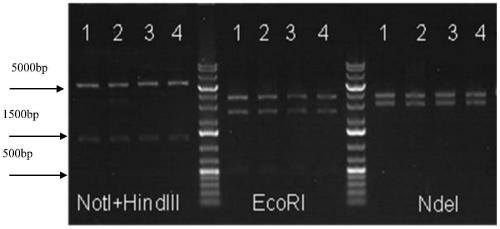A method for preparing ps1 gene conditional knockout flox rats
A gene and female mouse technology, applied in biochemical equipment and methods, genetic engineering, preparations for in vivo experiments, etc., can solve the problems of unknown PS1 gene function, no rat model, etc., and achieve simple preparation process and easy operation , high efficiency effect
- Summary
- Abstract
- Description
- Claims
- Application Information
AI Technical Summary
Problems solved by technology
Method used
Image
Examples
Embodiment 1
[0042] Example 1 Construction of PS1 Gene Homologous Recombination Vector
[0043] The design of the vector is to knock out the fourth exon of PS1 gene, so as to realize the inactivation of the whole gene. Firstly, three homologous recombination fragments (A, B, and C) were amplified from the genomic DNA of wild-type SD rat tissue, and connected to the LScKO vector by enzyme digestion to construct the PS1 conditional gene knockout vector plasmid. LScKO vector map see figure 2 . The source of the backbone (the vector backbone is pUC19, from Takara, product number 3219) was designed and modified by the inventor, and LoxP sites and multiple cloning sites were introduced into the vector, see figure 2 . The specific transformation method is as follows: a fragment DNA (such as SEQ ID NO.10) is synthesized by a plasmid synthesis company, the pUC19 vector is digested with EcoRI and HindIII, the synthesized fragment is connected to the pUC19 vector, and the sequence verification b...
Embodiment 2
[0068] Example 2 Construction of CRISPR / Cas9 Targeting Plasmid
[0069] 1. Design, synthesis and construction of sgRNA fragments:
[0070] Table 3 sgRNA fragment sequence
[0071]
[0072]
[0073] 1. The specific design is as follows:
[0074] (a) Find information about the PS1 gene on NCBI; the gene ID number is 29192, located on chromosome 6, about 47.98kb,
[0075] (b) Design sgRNA fragments using Crispr software (http: / / crispr.mit.edu / )
[0076] (c) The selected targets are analyzed on the NCBI database to determine knockout regions. Select the sgRNA site with fewer off-target sites, and finally locate the target site on exon 4.
[0077] 2. The 8 groups of sgRNA designed for the 5' end target site are numbered sgRNA1-sgRNA8, and the 8 groups of sgRNA designed for the 3' end target site are numbered sgRNA9-sgRNA16. The sequences are shown in Table 3. Use the UCA activity detection method independently developed by our company to detect sgRNA activity, and the 5'...
Embodiment 3
[0086] Example 3 Production of flox rats using CRISPR-Cas9 system mRNA targeting PS1 gene
[0087] 1. Microinjection and fertilized egg transfer
[0088] Get the pronuclear fertilized eggs of SD rats, use the microinjector to inject the mixture of the transcripts of the two groups of sgRNAs obtained in the premixed embodiment 2, Cas9mRNA and the recombinant vector prepared in the embodiment 1, into the rats for fertilization In the cytoplasm of the eggs, the injected fertilized eggs were transferred to the culture medium for short-term culture, and then transplanted into the oviducts of recipient female mice to develop, and 177 embryos were transferred to obtain 32 first-established mice (namely founder mice).
[0089] The specific method for preparing transgenic rats by microinjection is as follows:
[0090] 1) Choose well-developed SD female mice aged 4-5 weeks, intraperitoneally inject 20 IU of pregnant horse serum gonadotropin (PMSG), and inject 20 IU of human chorionic g...
PUM
 Login to View More
Login to View More Abstract
Description
Claims
Application Information
 Login to View More
Login to View More - R&D
- Intellectual Property
- Life Sciences
- Materials
- Tech Scout
- Unparalleled Data Quality
- Higher Quality Content
- 60% Fewer Hallucinations
Browse by: Latest US Patents, China's latest patents, Technical Efficacy Thesaurus, Application Domain, Technology Topic, Popular Technical Reports.
© 2025 PatSnap. All rights reserved.Legal|Privacy policy|Modern Slavery Act Transparency Statement|Sitemap|About US| Contact US: help@patsnap.com



